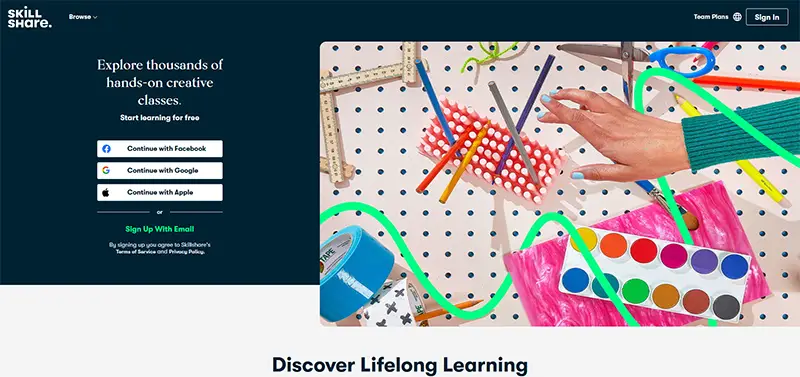Getting started in digital product sales can be full of unknowns. If you’re bootstrapping your side-hustle then being able to start selling with little / no upfront cost can be very attractive.
Sell digital products on an e-commerce platform if you already have a traffic-source of visitors. A marketplace is better if starting with no traffic. Both ways have free plans or trial periods but they will charge commissions on sales. Once sales pick up it is often better to switch to a paid plan where fees are lower.
Whichever option you choose to start with remember, that once the sales start rolling in you’ll most likely need to switch packages or platforms for the most cost effective solution.
If you find this post useful then make sure to check out How to Host a File for Download the Right Way and How to Make a Website for a Creative Side Hustle.
What is the Cheapest e-Commerce Platform to Start Selling Digital Downloads?
If you already have a traffic source of visitors to your website, social media or have an established email list then, selling digital downloads on an e-commerce platform is likely going to be the right option for you. You could also run paid ads to your sales page but I would not suggest this as a starting point for beginners since it can be more advanced.
The cheapest e-commerce platforms to start selling digital downloads are Gumroad, Podia and SendOwl. These platforms offer entry-level plans with no monthly fee. However, their transaction fees per sale are higher than paid plans. There are also free versions of WordPress plugins WooCommerce and Easy Digital Downloads.
If you’re selling online courses rather than digital downloads head down to the courses section of this post.
The comparison table below shows the cheapest plan on the most popular e-commerce platforms. The data is based on the cheapest monthly payment plan that allows selling of digital products.
| Platform | Monthly Fee (USD) | Fee per Sale (USD) | Product Cap |
|---|---|---|---|
| Shopify | $29 | 2.9% + $0.30 | Unlimited |
| Gumroad | Free | 9% + $0.30 | Unlimited |
| Kajabi | $149 | 2.9% + $0.30 | 3 |
| Katra | $99 | 2.9% + $0.30* | 20 |
| Podia | Free | 8%+ 2.9% + $0.30 | 1 |
| Sellfy | $29 | 2.9% + $0.30* | Unlimited |
| SendOwl | Free | 5% ($0.25 min) | Unlimited |
| Digital Product Delivery (DPD) | $10 | 2.9% + $0.30* | 20 |
| WooCommerce | Free (website required) | 2.9% + $0.30 | Unlimited |
| Easy Digital Downloads (EDD) | Free (website required) | 2.9% + $0.30* | Unlimited |
E-commerce platforms tend to have much lower transaction fees per sale when compared to selling on marketplaces but require you to send your own traffic to your products.
There are no completely free e-commerce platforms but there are a number of ways to start selling without paying anything until you start generating sales income.
Most platforms offer a free trial for 2-4 weeks where any monthly fees are waived. This allows you to test them out and see if they offer the features that are right for you. However, if you’re new to e-commerce it may not be enough time to start generating sufficient income to pay for the monthly fees.
Even more attractive, are the platforms that offer a free tier in exchange for reduced functionality or higher transaction fees per sale.
This could be a problem if you are trying to bootstrap your project and keep it self-funding.
Even more attractive, are the platforms that offer a free tier in exchange for reduced functionality or higher transaction fees per sale. These mean that you can get to grips with e-commerce with no upfront investment and change to a more cost-effective plan at a later date once you sales have grown.
The exception to this are e-commerce plugins for WordPress such as WooCommerce and Easy Digital Downloads. These offer free versions of the core software but require payment for customization and additional features.
With all of the platforms, there are always payment processing fees from the payment gateway such as Stripe or PayPal (usually 2.9% + 30c within the U.S. and more internationally).
Cheapest Marketplaces to Sell Digital Products
The cheapest marketplace to sell digital products is Etsy with fees being very low compared to royalty rates issued on most other platforms. The trade-off is that Etsy caters for a wide range of customers and is very competitive, meaning low prices. Specialized platforms tend to have higher prices but offer lower royalties.
Marketplaces are a good place to start selling digital products if you do not have an existing audience on social media or any website traffic. Selling on them is usually free so there is no up-front investment.
However, they usually have considerably larger transaction fees per sale than dedicated e-commerce platforms. Unfortunately that is the trade-off for getting access to their large customer base.
In addition to this, competition on marketplaces tends to push prices lower meaning that you’ll earn a small amount on each sale.
As you build a steady income from marketplace sales it is a good idea to simultaneously create traffic to your website and e-commerce platform sales pages. This will net you more profit as sales from these platforms increase.
See the table below for a summary of fees charged by some of the more popular marketplaces that allow digital downloads to be sold.
| Marketplace | Fees per Sale (USD) | Other Fees (USD) | Typical Digital Products Sold |
|---|---|---|---|
| Etsy | 6.5% + 3% + $0.25 (+15% if via an offsite ad) | $0.20 listing fee every 4months | Most Digital Products, Made-To-Order Digital Products |
| Design Bundles | 25% (non-affiliate), 50% (affiliate) | – | Graphics, Design Templates & Mockups, Fonts, Software Plugins, Brushes and Presets |
| Creative Market | 70% | – | Graphics, Fonts, Templates & Mockups, Photos, WordPress Themes, 3D Modelling Assets |
| Graphic River | 55% (non-exclusivity) | – | Graphics, Templates & Mockups, Fonts, Software Plugins, Brushes and Presets, Presentations, Game Assets |
| KDP | 30% | – | eBooks and Print-On-Demand Books |
| IngramSpark | 60% | $25 ebook setup | eBooks and Print-On-Demand Books |
Cheapest Platform for Selling Online Courses
The cheapest platforms to start selling online courses are marketplaces such as Skillshare and Udemy which have no monthly fees. E-commerce platforms usually have lower fees per sale with Thinkific also allowing the sale of one course for no monthly fee.
When considering which platform is cheapest it will depend on your sales volume.
Initially, you may want to consider platforms that offer lower monthly fees but switch to one with lower transaction fees once sales start to grow. This will allow you to keep more of your profits.
In addition, if you have no audience, then selling on a marketplace would be best, even though the fees per sale are much higher.
| Platform | Monthly Fee (USD) | Fees per Sale (USD) |
|---|---|---|
| Teachable | $29 | 5% |
| Podia | $39 | 2.9% + $0.30 |
| Thinkific | Free (1 course) | 2.9% + $0.30 |
| Udemy | Free (unlimited courses) | 3% + 3% (via referral link) 3% + 63% (via marketplace) |
| Kajabi | $149 | 2.9% + $0.30* |
| Skillshare | Free | Revenue share model based on viewed mins |
| LearnWorlds | $24 | $5 + 2.9% + $0.30* |
There are two types of platform to use for hosting paid online courses. Firstly, those that simply host your course and rely on you driving traffic to it. Secondly, course marketplaces where your course attracts students from their large customer base.
Course Hosting Platforms
Hosting on a Learning Platform that purely hosts your course can attract the lowest fees as it is up to you to do your own marketing. This is a great option if you have built an audience on social media, have a decent amount of website traffic or are willing to run paid ads to your course.
Paid ads are for more advanced sellers that have a grasp of digital marketing. The income can potentially be huge though.
For beginners or those without an existing audience, it may be worth starting on a Course Marketplace.
Course Marketplaces
Course Marketplaces are great if you don’t have an audience as you will be marketing to a large built-in one that the markeplaces such as Udemy attract. You will need to concentrate on creating a course that is attractive to students searching for it which includes optimizing your product listing and thumbnail, not to mention the actual content to keep refunds low.
For creative courses two of the most popular marketplaces are Udemy and Skillshare.

Udemy is a general learning platform for all kinds of courses but its sheer size makes it an attractive platform. Udemy offers what they call a revenue share model but since it’s based on the course sale price this is just a fancy way of writing the fact that they take fees like any other marketplace.
On the plus side, whilst they do take a large fee for students that find your course on their platform, this is greatly reduced if you’re referring a student directly. Potentially this makes it suitable for beginners and those that are gradually growing their own audience as well. See Udemy’s article on revenue share here and their instructor terms here.
The benefit to Udemy is their large customer base if you don’t have your own audience but it isn’t necessarily the most profitable place to sell a course overall.

Skillshare is a course marketplace that operates on a subscription model for students. They have also offer a revenue share model for authors which is based on a percentage of the Skillshare subscription income and scaled by how many mintues students view your courses. Your course is offered free of charge as a result.
This model makes it difficult to estimate earnings in advance but it can be very profitable if your courses are what their membership is searching for. See Skillshare’s article here for details on how the plan works. Students must have a Skillshare subscription so selling direct to non-subscribers can be difficult.
You’ll be relying on Skillshare’s built-in audience so making courses that appeal to them is critical. It is good for starting out if you have no existing traffic to your website and because Skillshare is aimed at creatives, the right course can earn more than Udemy.
Little promotion is required to sell on Skillshare or Udemy so are perfect if you want to stick to creating rather than selling. If however, you are happy to get stuck into e-commerce and digital marketing then you can earn more by selling on another platform where the fees are lower.
PayPal, Stripe and File Hosting Service
A bare-bones alternative way to sell digital downloads is to embed a payment gateway “purchase button”. This can be done with PayPal and Stripe. Store your file on a hosting service such as DropBox and use the url when setting up the button.
Now you can embed the button on your social media pages or a website for a simple way to sell your digital products.
One of the downsides with this method is that your link won’t be secure and could be shared once someone purchases.
Conclusion
So in conclusion, it is possible to sell digital products for free but it’s really only worth doing while your business is at an early stage. Starting with a marketplace or free tier of an e-commerce platform will serve you until you have built a following. After that, the sky’s the limit!
If you found this post useful then make sure to check out How to Host a File for Download the Right Way and How to Make a Website for a Creative Side Hustle.
Featured image: lartestudio / stock.adobe.com








